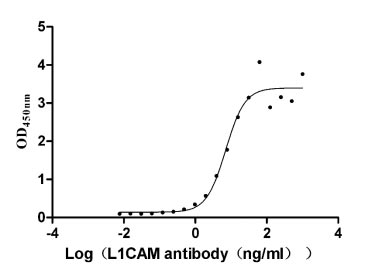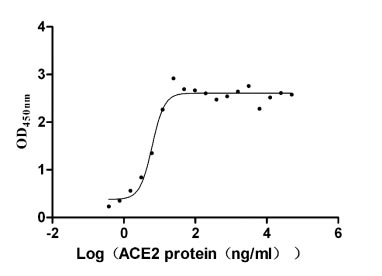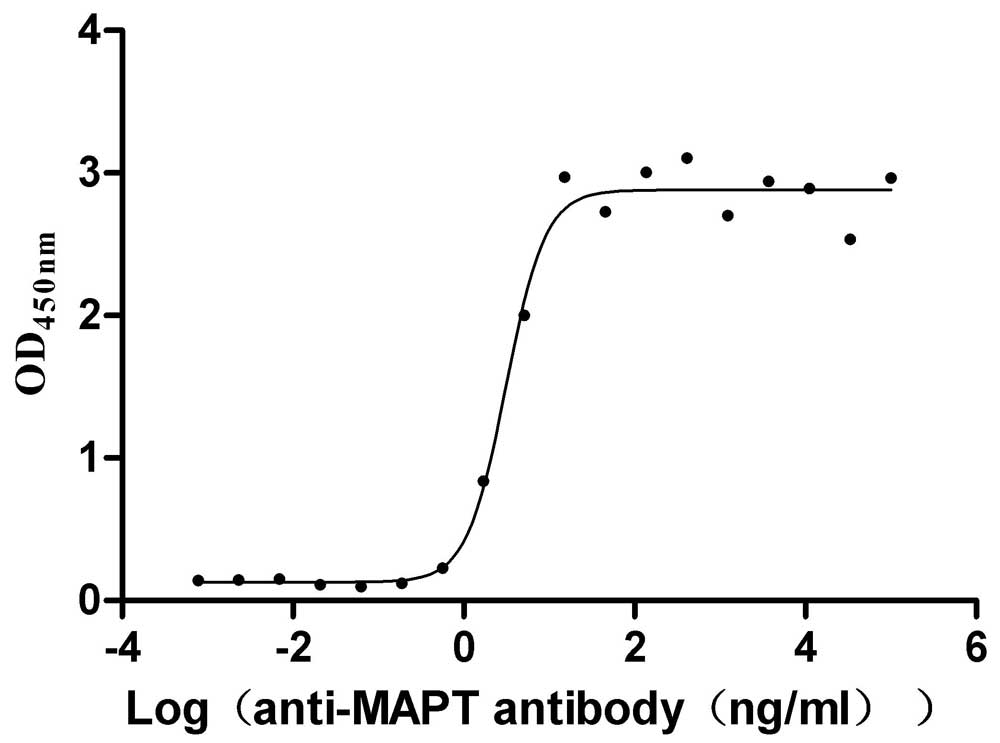Recombinant Human Beta-crystallin B1 (CRYBB1)
-
中文名称:Recombinant Human Beta-crystallin B1(CRYBB1),Yeast
-
货号:CSB-YP006012HU
-
规格:
-
来源:Yeast
-
其他:
-
中文名称:Recombinant Human Beta-crystallin B1(CRYBB1),Yeast
-
货号:CSB-EP006012HU
-
规格:
-
来源:E.coli
-
其他:
-
中文名称:Recombinant Human Beta-crystallin B1(CRYBB1),Yeast
-
货号:CSB-EP006012HU-B
-
规格:
-
来源:E.coli
-
共轭:Avi-tag Biotinylated
E. coli biotin ligase (BirA) is highly specific in covalently attaching biotin to the 15 amino acid AviTag peptide. This recombinant protein was biotinylated in vivo by AviTag-BirA technology, which method is BriA catalyzes amide linkage between the biotin and the specific lysine of the AviTag.
-
其他:
-
中文名称:Recombinant Human Beta-crystallin B1(CRYBB1),Yeast
-
货号:CSB-BP006012HU
-
规格:
-
来源:Baculovirus
-
其他:
-
中文名称:Recombinant Human Beta-crystallin B1(CRYBB1),Yeast
-
货号:CSB-MP006012HU
-
规格:
-
来源:Mammalian cell
-
其他:
产品详情
-
纯度:>85% (SDS-PAGE)
-
基因名:CRYBB1
-
Uniprot No.:
-
别名:Beta crystallin B1; Beta-B1 crystallin; Beta-crystallin B1; CATCN3; CRBB1_HUMAN; CRYBB 1; Crybb1; Crystallin beta B1; CTRCT17; Eye lens structural protein; OTTHUMP00000028719
-
种属:Homo sapiens (Human)
-
蛋白长度:Full Length of Mature Protein
-
表达区域:2-252
-
氨基酸序列SQAAKASAS ATVAVNPGPD TKGKGAPPAG TSPSPGTTLA PTTVPITSAK AAELPPGNYR LVVFELENFQ GRRAEFSGEC SNLADRGFDR VRSIIVSAGP WVAFEQSNFR GEMFILEKGE YPRWNTWSSS YRSDRLMSFR PIKMDAQEHK ISLFEGANFK GNTIEIQGDD APSLWVYGFS DRVGSVKVSS GTWVGYQYPG YRGYQYLLEP GDFRHWNEWG AFQPQMQSLR RLRDKQWHLE GSFPVLATEP PK
-
蛋白标签:Tag type will be determined during the manufacturing process.
The tag type will be determined during production process. If you have specified tag type, please tell us and we will develop the specified tag preferentially. -
产品提供形式:Lyophilized powder
Note: We will preferentially ship the format that we have in stock, however, if you have any special requirement for the format, please remark your requirement when placing the order, we will prepare according to your demand. -
复溶:We recommend that this vial be briefly centrifuged prior to opening to bring the contents to the bottom. Please reconstitute protein in deionized sterile water to a concentration of 0.1-1.0 mg/mL.We recommend to add 5-50% of glycerol (final concentration) and aliquot for long-term storage at -20℃/-80℃. Our default final concentration of glycerol is 50%. Customers could use it as reference.
-
储存条件:Store at -20°C/-80°C upon receipt, aliquoting is necessary for mutiple use. Avoid repeated freeze-thaw cycles.
-
保质期:The shelf life is related to many factors, storage state, buffer ingredients, storage temperature and the stability of the protein itself.
Generally, the shelf life of liquid form is 6 months at -20°C/-80°C. The shelf life of lyophilized form is 12 months at -20°C/-80°C. -
货期:Delivery time may differ from different purchasing way or location, please kindly consult your local distributors for specific delivery time.Note: All of our proteins are default shipped with normal blue ice packs, if you request to ship with dry ice, please communicate with us in advance and extra fees will be charged.
-
注意事项:Repeated freezing and thawing is not recommended. Store working aliquots at 4°C for up to one week.
-
Datasheet :Please contact us to get it.
相关产品
靶点详情
-
功能:Crystallins are the dominant structural components of the vertebrate eye lens.
-
基因功能参考文献:
- We examined a cohort of Chinese patients with congenital cataracts and studied the phenotypes and genotypes. Extralenticular abnormalities, such as microcornea and ocular coloboma, can also be found in patients with congenital cataracts. The phenotype of congenital cataracts associated with macular and optic disc coloboma was reported for the first time in this study. PMID: 29386872
- Our findings highlight the importance of the C-terminus in betaB1-crystallin in maintaining the crystalline function and stability, and provide a novel insight into the molecular mechanism underlying the pathogenesis of human autosomal dominant congenital cataract. PMID: 28928627
- CRYBB1 partial duplication ad complete duplication of CRYBA4 identified in a family with autosomal dominant congenital cataract. PMID: 28272538
- Molecular dynamic simulation studies indicated that the mutation decreased the subunit binding energy and modified the distribution of surface electrostatic potentials. More importantly, the mutation separated two interacting loops in the C-terminal domain, which shielded the hydrophobic core from solvent in native betaB1-crystallin. PMID: 27318838
- Congenital microcornea-cataract syndrome-causing mutation X253R increases betaB1-crystallin hydrophobicity to promote aggregate formation PMID: 27208166
- Despite the disruption of betaB1-crystallin assembly, the thermal stability of betaB1-crystallin was increased by the mutation accompanied by the reduction of thermal aggregation at high temperatures PMID: 23159606
- Sequencing of this gene revealed a homozygous c.171del mutation (p.N58Tfs*107) with a shared haplotype in all 16 children. PMID: 22267527
- study identified a novel heterozygous p.Ser129Arg mutation in CRYBB1 in a congenital cataract-microcornea syndrome family of Chinese origin PMID: 21972112
- The formation of beta-crystallin heteromers not only stabilizes the unstable acidic beta-crystallin but also protects them against aggregation during refolding from the stress-denatured states. PMID: 22032798
- The presence of significant amounts of small peptides derived from gammaS- and betaB1-crystallins in the water-insoluble fraction of the lens indicates that these interact tightly with cytoskeletal or membrane components. PMID: 21447408
- Analyses of 20 Chinese families with hereditary nuclear congenital cataract revealed 3 novel mutations. Two of these mutations (V146M and I21N) affected betaB2-crystallin (CRYBB2). One mutation (R233H) was detected in betaB1-crystallin (CRYBB1). PMID: 21402992
- Variant alleles of the CRYBB1 and CRYBB2 genes were found, none are considered pathogenic. PMID: 20565250
- Data show a significant demixing of gammaD and betaB1 i.e., large difference of composition in the two coexisting phases. PMID: 20616077
- Mutation G220X is associated with autosomal dominant cataract. PMID: 12360425
- 1.4 angstroms resolution crystal structure of a truncated version of human betaB1 that resembles an in vivo age-related truncation PMID: 14573871
- The molecular characterization of a UK family with an autosomal dominant congenital cataract associated with microcornea is reported PMID: 16110300
- fundamental transcriptional regulatory mechanism of the betaB1-crystallin gene has been well conserved between humans and zebrafish PMID: 16331646
- the sequence of betaB2-crystallin appears well optimized for domain swapping PMID: 17327390
- The dimeric intermediate may be a critical determinant for the life-long stability of the beta-crystallins and has important consequences on interactions with alpha-crystallin. PMID: 17448466
- The current study showed that a different mutation in the same gene causes an autosomal recessive form of the disease. PMID: 17460281
- study identified a novel mutation in CRYBB1 gene in a Chinese family with autosomal dominant congenital cataract; results provide strong evidence that CRYBB1 is a pathogenic gene for congenital cataract PMID: 17531125
- This study has identified a novel nonsense mutation in CRYBB1 (p.Q223X) associated with autosomal dominant congenital nuclear cataract. PMID: 18432316
- study identified an initiation codon mutation in CRYBB1 in a family with autosomal recessive form of congenital cataract (nuclear pulverulent cataract) PMID: 19461930
显示更多
收起更多
-
相关疾病:Cataract 17, multiple types (CTRCT17)
-
蛋白家族:Beta/gamma-crystallin family
-
数据库链接:
HGNC: 2397
OMIM: 600929
KEGG: hsa:1414
STRING: 9606.ENSP00000215939
UniGene: Hs.37135
Most popular with customers
-
Recombinant Human Neural cell adhesion molecule L1 (L1CAM), partial (Active)
Express system: Mammalian cell
Species: Homo sapiens (Human)
-
Recombinant Paguma larvata Angiotensin-converting enzyme 2 (ACE2), partial (Active)
Express system: Mammalian cell
Species: Paguma larvata (Masked palm civet)
-
Recombinant Macaca mulatta Microtubule-associated protein tau (MAPT) (Active)
Express system: Mammalian cell
Species: Macaca mulatta (Rhesus macaque)
-
Recombinant Rabbit Tissue factor pathway inhibitor (TFPI) (Active)
Express system: Mammalian cell
Species: Oryctolagus cuniculus (Rabbit)
-
Recombinant Human C-X-C chemokine receptor type 4 (CXCR4)-VLPs (Active)
Express system: Mammalian cell
Species: Homo sapiens (Human)
-
Recombinant Rat Microtubule-associated protein tau (Mapt) (Active)
Express system: Mammalian cell
Species: Rattus norvegicus (Rat)
-
Recombinant Human Epithelial discoidin domain-containing receptor 1 (DDR1), partial (Active)
Express system: Mammalian cell
Species: Homo sapiens (Human)
-
Recombinant Macaca fascicularis Membrane spanning 4-domains A1 (MS4A1)-VLPs (Active)
Express system: Mammalian cell
Species: Macaca fascicularis (Crab-eating macaque) (Cynomolgus monkey)






-AC1.jpg)













